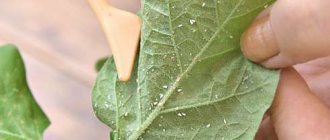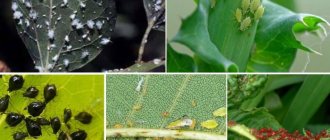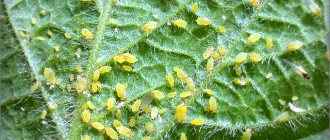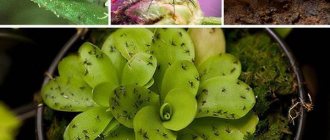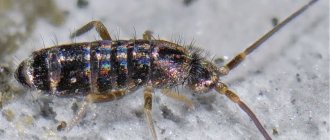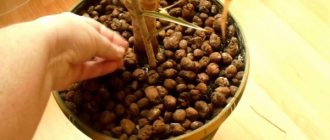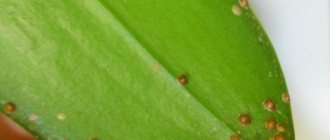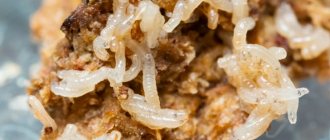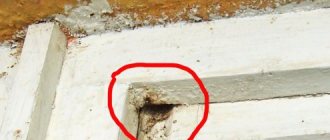Poduras, springtails, forktails
Poduras, springtails, forktails are synonymous names for the springtail species.
What do they look like and how to recognize them? Insects are small in size (approximately 1-2 mm long), have an oval body, white color, and do not have wings. As for the home, they live in the soil of indoor plants, where they develop due to excessive watering, and can also appear on the surface of the water in aquariums. They are clearly visible on the soil or bottom of a flower pot. Springtails and forktails will not cause significant harm, since they feed on plant roots that have rotted as a result of oversaturation of the earth with water. It is also worth noting that some types of springtails can rid the soil in a flower pot of small pests - worms, thereby bringing only benefits. However, if poduras reproduce, they can cause much more harm: a large number of springtails will destroy shoots and young roots.
In our article we will tell you what preventive measures you should follow to prevent springtails and forktails from disturbing your indoor plants, and what means and preparations you can use to get rid of springtails at home.
What do people advise?
- An infusion of tobacco dust, shag, and red hot pepper is used as a watering solution. Infuse a pound of tobacco waste or shag in 10 liters of water for 48 hours. Add soap shavings (40g) to the strained mixture. The plant itself is sprayed with the finished product and the soil is watered.
- You can also cultivate the soil with a weak solution of potassium permanganate.
- Dry celandine is used. 1 kg of raw materials is poured and infused in water (10 l). The infusion, aged for 24 hours, is filtered. They cultivate the soil.
Radical means of control will not be needed if plant nutrition and watering regime are properly organized and a healthy indoor microclimate is created.
Check out articles on similar topics
- Root mite control: what determines its effectiveness?
- How to get rid of scale insects and remedies on indoor plants
- How to get rid of whitefly pest on indoor plants and flowers
- Thrips on indoor plants: methods of control and treatment
Comments
leave a comment
Preventive measures
Preventive measures are necessary to ensure that the soil of your orchid, rose violet or other indoor plant does not multiply podurs, which threaten to harm the flowers by slowing down their development. As we have already noted, springtails feed on rotten debris and microorganisms, which promotes soil formation, however, once you start the situation, an innumerable number of insects will jump around the flower pots. It is unlikely that you want such neighbors for yourself. In order not to lead everything to the fight against fools, adhere to the preventive measures disclosed below.
- Replanting or digging up soil, when it comes to greenhouses and the threat of harm to seedlings, must be carried out carefully. Poduras live in places with high humidity, so greenhouse soil and waterlogged soil in indoor plants are an ideal environment for springtails and forktails. To prevent these insects from developing in the ground, the soil in the pots should be replanted and loosened in the greenhouse.
- The main reason for the appearance of dura is excessive watering. By eliminating this sign, the flowers will not suffer from “pests”. Moisten the soil again only when it is completely dry after the previous watering.
- Don't overuse fertilizers, as this can also encourage springtails to appear and multiply. If the soil is oversaturated with natural fertilizers, it is better to replant the indoor plant.
- Wipe flower pots, window sills, flowerpots, shelves, etc., in which and on what you have plants.
- In order not to find foul grass in your garden or greenhouse again after winter, do not forget to clean the garden of organic debris (for example, remove fallen leaves in the fall), whiten the trees, thereby ridding the bark of insects.
Remember about prevention, and springtails, forktails and other fools will not appear in your indoor roses, orchids, violets, and greenhouse seedlings will remain safe and sound.
Folk remedies for controlling podars, springtails and forktails
Folk remedies for fighting springtails are good because they are completely harmless to plants, while the use of some chemicals is dangerous. It is not difficult to combat soil pests. The following folk recipes will help you get rid of forktails and springtails at home:
- Watering. Do not water your flowers much or at all for a while. As soon as the soil loses excessive moisture, the springtails will leave the indoor plants on their own.
- Tobacco, or more precisely, dust. Sprinkle the soil in the pot with tobacco dust - and the problem will go away.
- Askofen or Citramon tablets. Prepare the solution: divide one tablet into two parts and fill one half with two to three liters of water at room temperature. Once the tablet has completely dissolved, pour the liquid over the flowers. This will prevent the reproduction of fools.
- Water. "Like water?" - you ask, if it is with its help that the fools obtain an ideal habitat. This means the following: take a deep basin or other container, place a flower pot in it and fill it with water so that it covers the top layer of soil. Once you do this, the springtails and forktails will float, and you can easily catch them from the water surface.
- Potato. Take a couple of pieces and cut them in half. Place the inner side on the soil in the pot. After a few hours, you will see how the fools came to the surface and settled on parts of the potatoes. You can carefully remove the vegetable halves along with the insects. We recommend repeating the procedure, since a one-time use will not destroy all the poisons at once.
- Yarrow. Water the soil with a tincture of this herb and the springtails will disappear.
- Hot pepper. Here the recipe is the same as with yarrow: use hot pepper infusion when watering.
- Mustard. Sprinkle the powder over the surface of the soil and the problem will disappear.
- Potassium permanganate. It is necessary to prepare the solution in a transparent container: pour 2-3 liters of warm water, dip the edge of a toothpick into the liquid, then dip this edge into potassium permanganate, stir thoroughly. Pour the resulting solution and settled water into the watering container. You can water indoor plants.
Folk methods of struggle
There are a number of ways to control insects without using chemical insecticides:
Mustard solution
150 g of powder is poured into 10 liters of hot water and left for 24-48 hours. Water the soil with the infusion. If there is a small amount of podur, lightly sprinkle the surface of the soil with dry mustard powder.
Infusion of marigolds
Flower bushes are filled with water and left for 2 days. Use the infusion for watering.
Mulching with wood ash
The soil is sprinkled with ash in a 1 cm layer.
Decoction of chamomile, calendula or yarrow
20 0 g of dry herbs are poured into 5 liters of water, brought to a boil and cooled. Water the soil with the resulting decoction.
Potatoes will help reduce the number of parasites in a greenhouse. Tubers cut in half are laid out on the beds, and after a while insects accumulate on them. The potatoes are carefully removed along with a small amount of soil and destroyed.
Treatment with chemicals
It is possible to treat indoor plants or seedlings in a greenhouse with chemicals, but you should know: there is a risk of harm. Fighting with insecticides is allowed only in case of global reproduction of insects. Having chosen this method of getting rid of springtails and forktails, you need to take precautions to protect yourself and keep children and pets away from the flower that is being treated with chemicals.
Insecticidal preparations such as “Aktara”, “Bazudin”, “Grom-2”, “Inta-Vir”, “Mospilan”, “Pochin” and others are suitable for combating durs. Almost all of them are in powder form. It is worth scattering “Bazudin” or “Pochin” over the surface of the earth, mixing a little with the topsoil if you are using “Pochin”, and within a few hours you will achieve the desired result - the fools will die. When treating indoor plants with chemicals, strictly follow the instructions on the packaging.
If you find a springtail or forktail on the soil of a houseplant, you should not panic or worry. These insects in small numbers will not lead to the death of the flower, but, on the contrary, will help somewhat. But, of course, it’s unpleasant to realize that flower pots are inhabited by poduras, so you can simply stop watering the plant for a while. If the situation is advanced and the springtails have multiplied, choose the method of control at your discretion.
We shared with you how to get rid of fools at home.
Fools
When a florist first notices a dud in a flower pot, he literally freezes with horror. Of course, in the bowl with the flower there are countless small white insects with antennae crawling around. Insects not only crawl, but also jump - there is something to be afraid of. In fact, poduras (and that’s exactly what they are) are not pests and in most cases are safe for the plant. But you should not ignore insects and leave them to live and enjoy the plant - by reproducing in large quantities, fools can cause significant harm. Homemade violets (Saintpaulias) especially suffer from them. So, let's talk about fools in more detail...
Harm and results
Single insects will not cause damage to either indoor plants or aquarium vegetation. However, in the case of vigorous reproduction, a colony of hungry insects switches to live food. Having stuck to the root system, insects drink the juice and injure the stems and leaves of domestic flowers. Fresh seedlings are especially affected by them.
To reproduce many springtail species, the participation of two partners in the process is not required. Males lay a seed protected by a transparent sphere. The female is fertilized on her own, having stumbled upon spermatophores, and in order for the seed to catch her eye, a whole gallery of transparent balls with seminal fluid is planted.
Entomological classification
As is often the case, when talking about fools, flower growers do not mean real fools, insects of the family Poduridae (Podurids), but their closest relatives - springtails from the families Hypogastruridae and Entomobryidae, subclass Collembola (Collembolas). Collembolas are a order of cryptomaxillary, which includes about 8 thousand species.
Real fools do not live in the soil of indoor plants at all; their habitat is ponds, puddles, and swamps. Their diet consists of simple fungi, mosses, lichens and algae. But the springtails Hypogastruridae and Entomobryidae are our home flower lovers. But, since this is how it is, we will continue to call springtails fools.
Fools - appearance
How can you tell if your flower is full of fools?
Poduras look like small white or cream-colored caterpillars with short antennae. There are specimens painted in a greenish or silvery tint. The size of the insects is approximately 2 mm, in some cases it can reach 1 cm. A special fork is attached to the underside of the abdomen, thanks to which the podras can not only crawl on the soil, but also jump, pushing off the surface with the fork. It is by this feature that an inexperienced gardener can distinguish the dur from other pests, such as mealybugs.
Beginning gardeners confuse podur not only with mealybugs, but also with insects such as fungus gnat larvae or thrips. But although all these insects are white or cream-colored, it is very easy to distinguish springtails by their ability to jump on the surface of the soil.
Podura larvae look approximately the same and differ from adults only in size.
Morphology
Springtails got their name due to a special jumping organ (jumping fork) located on the underside of the abdomen. The fork is held in a “cocked” state by a special hook. If necessary, the fork is released and, hitting the ground, throws the collembola forward and upward. Some springtail species have an elongated fusiform body shape. They are traditionally called fools. The other part is distinguished by a rounded abdomen and a spherical body; they are usually called sminturs. In a strict sense, this is not entirely correct. Sminturs are only part of the springtails that have this spherical body shape.
Springtail larvae completely repeat the body shape of adult individuals, differing from them only in size and maturity.
The color of springtails (podur and smintur) is very diverse. Most species have a whitish, gray, yellowish, or brownish color, sometimes with a metallic sheen. Representatives of some genera may have a marbled pattern, or less often one or more transverse stripes. Some mints may have a clear dot pattern.
When growing indoor plants, most often found are white, grayish in color, sometimes with a greenish or silver-metallic sheen.
Photo 2. Jumping fork.
When do fools appear?
A small number of springtails are almost always present in the soil of houseplants. When their population is small, podurs are not noticeable and do not interfere with the plant in any way. But as soon as the gardener begins to overwater the flower, thus provoking the creation of a nutrient-rich environment for springtails, the springtails enter the stage of active reproduction, their numbers are actively growing, and now insects become a problem for the plant and the gardener.
[!] Podura for the gardener is always a signal that watering should be reduced!
If you overwater a plant and the water stagnates on the surface of the soil, forming silt, expect uninvited guests.
The optimal habitat for springtails is moist soil and parts of the plant that begin to rot from waterlogging. The products of rotting are the best food for fools.
Very often, podurs appear on plants that constantly need a moist environment (pallets with water, moistened soil), for example, on cyperus. In such cases, you should not reduce watering and deprive the plants of their usual living conditions, and you need to fight the fools with the help of insecticides or folk remedies.
Damage from fools
Poduras, especially small specimens, cause virtually no damage to the plant. The only exception is young seedlings of Uzambara violet (Saintpaulia). Moreover, only the largest individuals can cause damage to the violet.
Another possible harm from these insects is in the case of a large population and low room temperature. Under such conditions, plants slightly damaged by durs become very vulnerable to various infections and rots.
How to recognize
Certain signs will help you suspect the appearance of springtails on indoor flowers:
- with high humidity, a white coating is noticeable on the soil surface, and tiny insects swarm there;
- parasites grow up to 2 mm in length, jump high, and actively move along the ground;
- Depending on the species, podars range in color from almost white to brown. The body of parasites is elongated;
- tiny insects rarely climb to the top of plants and spend most of their time on the surface of the soil in a flowerpot. With active reproduction and an abundance of moisture, pests “occupy” the root system, suck out juices, and damage the top layer of stems.
Types of springtails:
- white. The insect feeds on the top layer of soil and often appears in greenhouses and greenhouses, where humidity is constantly increased;
- vegetable. The parasite damages ornamental crops in greenhouses and interferes with the development of seedlings. Insects often live in summer cottages;
- mushroom The pest is dangerous for young shoots, seedlings, champignons, and bulbous flowers.
How to get rid of idiots
Ecologically safe and folk remedies for the fight against fools
Before using chemicals that can cause irreparable harm to the plant itself, try simpler control measures.
The most effective and simplest way is to reduce or completely stop watering the plant for a while. Having been deprived of their usual and comfortable habitat, the fools themselves will disappear and will no longer disturb the plant.
Pay close attention to the composition of the soil: it is important to exclude from the soil mixture components that cause the development of mold and mildew. Such elements can be sawdust, tea leaves, dry leaves. Equally important is proper drainage in the container with the plant. All factors that in one way or another cause rotting, mold and acidification of the soil must be completely eliminated. You can dilute the substrate with dry sifted sand. In clean soil, without food, springtails cannot live.
Another original recipe for getting rid of springtails is as follows: the pot with the plant must be placed in a basin or bucket so that the walls of this container are higher than the container with the plant. After this, water is poured into the basin so that it completely covers the bowl. As a result of these manipulations, the fish will float to the surface of the water, after which they can be caught.
A folk method that is completely safe for both the plant and humans: take a potato tuber and cut it in half. Place the potato halves in the bowl with the plant, cut side down. After a few hours, the springtails will gather on the potato sections. After this, you can carefully remove the potato from the ground, holding it with a spatula from below, and shake off and destroy the collected potatoes. The procedure will need to be repeated several times, since it will not be possible to collect all the insects the first time.
As a preventive measure, always disinfect the soil before planting a young plant or seeds: keep the soil in the oven at a temperature of about 220 ° C for 20-30 minutes. This simple method will allow you to get rid of not only podura larvae, but also other insects.
Insecticides in the fight against podura
Insecticidal preparations should be used only when the springtail colony has become very numerous. It is very important to follow all safety measures and limit children and pets’ access to the processed plant.
The drug Bazudin is suitable for the destruction of duras. The drug is scattered on the surface of the soil in a thin layer, after a few hours all the fools will die.
Pochin is another drug effective in the fight against springtails. The method of application is the same as for Bazudin - scatter the granules over the surface and mix a little with the ground. The drug begins to act immediately, within a few hours all insects will be destroyed.
The drugs Mospilan, Aktara and other drugs that are effective against most pests can also be used to control springtails. When preparing the solution, strictly follow the instructions on the package.
Briefly about the most important...
If you find that there are poduras in the bowl with the plant, don’t worry. These insects are practically harmless and are part of the natural soil fauna. Just reduce watering and insects will no longer bother your flower.
How to control pests on indoor plants
Scale insects on indoor plants
Many novice gardeners are wondering how to deal with pests of indoor plants. The answer to this is important, since insects multiply rapidly, time must not be wasted.
There are different ways to help get rid of pests:
- mechanical;
- biological;
- folk;
- chemical.
If pests of indoor plants are correctly identified, and measures to combat them will be effective.
Mechanical
You need to start with the measures that are safest for humans, especially since they often help a lot. Before starting work, you should disinfect and sharpen your tools. All damaged leaves and shoots are cut off, and the cut areas should be sprinkled with activated carbon. Bugs and visible larvae are selected manually: scale insects, slugs, caterpillars. Leaves with pests such as aphids can be wiped with a cotton pad. A contrast shower and spraying with water helps get rid of pests living on the green parts of the plant.
Biological
How to fight harmful insects with biological means? Such preparations are created based on plants. Most often used:
- "Fitoverm";
- "Agrovertin";
- "Iskra-Bio".
Before use, you should read the instructions. Since they destroy pests, they contain poison in small doses. The plants are treated early in the morning and left in a shaded place until all parts of the plant are dry. The room where the treatment was carried out is ventilated. You need to wash all exposed parts of the body with warm water and detergent.
Traditional methods
If indoor plant pests appear, treatment can be carried out with time-tested folk remedies. For this, decoctions and infusions are prepared from:
- yarrow;
- chamomile;
- dandelion;
- marigolds;
- nettle;
- garlic;
- Luke;
- peels of oranges, tangerines, lemons.
These environmentally friendly and harmless plants can effectively destroy harmful insects. Steamed citrus peels can be buried in the soil. Insects don't like their smell.
An infusion of tobacco, stove ash, a solution of potassium permanganate, furatsilin or soda works well. To prevent the liquid from immediately draining from the plants, laundry soap is added to it.
Chemical
When using chemical pest control products, rapid success can be achieved. It is better to resort to their help as a last resort if other methods have not given a positive result. It should be remembered that such products are unsafe for humans and beneficial insects. You need to work with chemicals with the window open, removing children and animals from the room. In addition, when working you need to use personal protective equipment. After work, you need to thoroughly wash your hands and face. The treated plants are placed in the shade until the solution is completely dry. The area where the treatment was carried out must be washed with hot water and detergents. Remember that chemicals are toxic, therefore, they should be stored in places inaccessible to children and pets. Popular and effective remedies for pests of indoor plants:
- "Karbofos";
- "Chlorophos";
- "Syphos";
- "Trichlorometaphos";
- "Pyrethrum";
- "Decis";
- "Fury."
They are capable of destroying almost all harmful insects.
Appearance and behavior characteristics
Podurs living in pots are close relatives of the inhabitants of reservoirs. They also prefer high humidity. What do idiots look like? The body shape is elongated, segmented, reminiscent of caterpillars. The color is transparent white, sometimes gray. Body length is 2-3 mm. Whiskers are noticeable on the head.
Their distinctive feature is a growth in the back of the body called a jumping fork. This process allows springtails to push off from the surface and make a jump. A characteristic feature of behavior helps novice gardeners distinguish the podura from another pest - the mealybug. Outwardly, these small whitish pests are very similar, but springtails do not suck plant juice like scale insects. At rest, the fork tucks under the abdomen.
Information. Not all springtail species have a jumping fork; some only crawl using their pectoral legs.
Springtails reproduce by laying eggs. The female buries the clutch into the soil to a depth of 3 cm. The emerging larvae are a miniature copy of the parents.
Adults are quite active; they can be seen on the surface of the ground, on the windowsill near the flowers, or near the drainage hole at the bottom of the pot. In small quantities they are harmless. With uncontrolled reproduction, arthropods eat all the organic matter in the soil and attack the roots and shoots of the plant. More often than other flowers, violets and orchids suffer from the invasion of jumping pests.
Attention. The appearance of dura is a kind of indicator of systematic excess of watering norms.
Description of springtail
Springtails, or springtails, are extremely widespread, especially in temperate latitudes, there are many of them in the tropics, they are found both in the Arctic and Antarctic - wherever there are at least mosses and lichens.
Springtail Tomocerus vulgaris.
These insects most often live among rotting plant remains and in the surface layer of soil, but many also live deep in the soil, often penetrating deeper than other animals. Among springtails, there are also those that live on the surface of plants, and there are even those that have passed on to life on the surface of a film of water.
The number of springtails is also very large. For example, in the soils of forests and meadows there are often several tens of thousands of springtails per square meter. Springtails are very diverse both in body shape and color: as a rule, species that live in the soil and do not leave it are white, springtails that live on the surface of green plants, greenish, but among those living in the forest litter or in the felt of dead herbaceous plants , along with grayish and brown ones, brightly colored or metallic shiny species are not uncommon.
springtail
Those springtails that live on the soil surface can move in a very unique way. As already noted, on the lower surface of the posterior end of the abdomen there is a special organ not found in other arthropods, the so-called “jumping fork.” In a calm state, it is tucked under the abdomen. Quickly straightening this “fork”, the collembola pushes off from the object on which it sits and makes a sharp jump.
Springtails that stay on the surface of the water (there are some) can jump, pushing off even from the surface film of water - their body is not wetted by water.
White springtails,
which always live in the ground and do not appear on the surface, do not have a “jumping fork”; they can only crawl with the help of short chest legs, often not even noticeable when viewed from above. A number of springtails harm plants, as
green smintur
, or sometimes eaten en masse into the succulent roots of greenhouse plants
onychiura
. Some species probably cause harm indirectly by spreading fungal spores that cause plant diseases.
Podura in a pot of orchids
The most common option is the appearance of nimble pests on orchids growing in moss. If springtails are noticed on the substrate, this is a signal that the conditions of the plant have been violated. Poduras appear on an orchid in several cases:
- The soil is waterlogged, which leads to rotting of roots, stems and pseudobulbs, and infectious diseases may subsequently arise.
- The flower does not receive enough sunlight, so it does not have time to use up moisture during the period between waterings.
The desire to quickly destroy pests arises not only because of their potential threat to plants, but also because of their unsightly appearance. How to get rid of dura in orchids? To do this, it is recommended to replant the plant. Before the procedure, it is necessary to wash the root system with warm water. This will wash away eggs and larvae, invisible due to their small size. During transplantation, you can clearly see the roots. Rotten and dried parts are removed, the fabrics are cleaned to a healthy green color. Treated areas must be disinfected. Most often, activated carbon powder is used (to prepare it, you need to crush several tablets purchased at the pharmacy).
Prevention
As practice shows, it is easier to prevent plants from becoming infected with podura than to treat them later. Preventive measures:
- It is better to purchase plants only in specialized stores, where sellers can provide all the necessary documentation and quality certificates.
- It is important to provide a high-quality drainage layer to prevent excessive moisture accumulation.
- Select the right planting material.
- Provide proper care for the plant, taking into account all its individual needs.
- Systematically conduct an external inspection of plants (experienced gardeners recommend doing this at least once every two weeks).
- If you notice an affected plant, it must be immediately isolated from the rest to prevent the spread of pests.
Springtails will never grow in a room where cleaning is done regularly and there is no mold.
Pest on violets
Springtails are present in almost every indoor plant soil. Several miniature individuals are difficult to notice; they leave no signs of their existence. As humidity levels rise, adults begin to reproduce intensively. In damp soil, the roots rot, and rotten organic matter is the main source of food for fools. The number of springtails increases, they begin to jump, appear floating in trays of water. The damage from springtails increases at low room temperatures. Unfavorable conditions slow down the growth and regeneration of indoor plants. Even minor damage turns into serious problems.
Heavy acidifying soil in pots with violets is a violation of agrotechnical growing conditions. Some species of fools cause damage to young violet seedlings. Damaged plants become vulnerable to diseases and other pests. Springtails are also carriers of fungal spores that cause disease.
Methods of pest control
Most springtails, and there are about 8 thousand species of them, lead a secretive lifestyle. Their diet includes fungal mycelium, algae, and lichen. A limited number of springtails feed on plants, but this is what gardeners have to deal with.
Methods for getting rid of dura on indoor flowers can be divided into several groups: mechanical, agrotechnical, folk and chemical.
- it is effective for small infections;
- light particles of the substrate float up - expanded clay, peat.
Mechanical methods of control include cleaning trays, pots, shelves or window sills where flowers stand with a soapy solution.
Advice. Do not leave water in the pan; pour it out half an hour after watering.
The most effective way to combat durs is to reduce watering and dry the soil. Loss of moisture is detrimental to them. The lump of earth is dried in the air in the shade or blotted with napkins. Not every plant can withstand prolonged drought, so you will have to act based on each type of indoor flower. It is worth reviewing the composition of the soil; organic residues are excluded from it - tea leaves, dry leaves. These components promote the growth of fungi, a breeding ground for springtails. Proper drainage is necessary so that moisture does not stagnate in the soil.
Advice. The pot should be selected according to the size of the root system. With a large volume, simple fungi and bacteria fill the free space. A favorable environment is created for the development of springtails.
If there is a large accumulation of pests on the surface, the top layer of soil is replaced. 3-4 cm of soil are removed and clean sand is poured in their place. After 4-5 months, the sand can be replaced with soil. Sprinkling the soil with ash is also effective; this worsens the living conditions of pests.
Folk recipes
A simple and safe way is to lure pests from the pot into the potatoes. To do this, take a raw vegetable and cut it in half. Half a potato is placed cut side down in the ground. Springtails will gather around him. Remove the pests with a spatula, along with the soil. You need to act quickly, but carefully. The collected poduras are placed in a container with a lid (don’t forget about their jumping ability) and then destroyed. This method will not get rid of all pests, but it will significantly reduce their population.
To repel pests, it is recommended to place dry peels of citrus fruits - oranges or lemons - in pots. Sprinkling a thin layer of tobacco dust will help. Watering with the addition of a citramone tablet per 2 liters of water helps control the number of springtails. If the above methods are ineffective, you will have to replace the soil.
Control measures
Podura are almost always present in volumes with mature plants, and it is not necessary to conduct a directed fight against them with normal agricultural technology. The main measure to combat outbreaks of podar numbers can only be compliance with the conditions of correct agricultural technology for growing plants. The substrate should not contain a large number of actively decomposing components (unrotted leaves, tea leaves, decorative sawdust). The volumes must have good drainage to prevent stagnation of moisture in the soil. Watering is moderate, as the soil dries. The volume of the pot should correspond to the size of the root system. The place not occupied in the near future by plant roots will be occupied by fungi, bacteria, algae, the earth will turn sour, and fools will breed.
The number of duras remarkably restrains a number of predatory mites, which are also almost always present in the soil.
If there are too many muds, change the soil to a new one. If history repeats itself, then reconsider the soil composition and watering regime.
In cases where you need to take urgent measures to reduce the number of poduras, you can use systemic insecticides (Mospilan, Aktara, etc.). You can restrain and somewhat limit the number of fools by also adding citramon or askofen to the water for irrigation (half a tablet per 2-3 liters of water).
When sowing Saintpaulia and Streptocarpus seeds, the soil must be thoroughly steamed. The container in which the seeds are sown must be sealed and have no drainage holes accessible to the pest. It is especially important to comply with these requirements when there are few seeds or the germination rate of the seeds of a given hybrid is very low.
